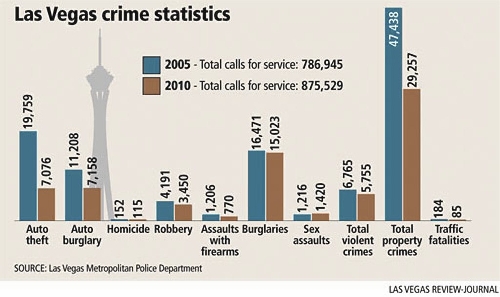Sexual assaults increase in Las Vegas as all other violent crimes drop
Violent crime in Las Vegas continued its multi-year downward trend in 2010 with one big exception: sexual assaults.
"We have not been ringing the bell there," Clark County Sheriff Doug Gillespie said at a Thursday news conference on just-released crime statistics for the area handled by the Metropolitan Police Department.
The bad news on sex crimes was the department's lone black eye in an otherwise "impressive year," Gillespie said. Violent crimes have fallen 15 percent since 2005, including three straight years of declines even as the economy has been on the skids. The department's crime statistics follow a nationwide trend.
Gillespie said many analysts had predicted the police winning streak would end in 2010.
"People probably questioned our ability to do it (decrease crime),'' he said. "I'm very, very proud of our organization and community."
Almost all major crime categories saw double-digit percentage decreases since 2005, though the department handled 11 percent more service calls.
Yet sex crimes increased 16 percent over that time.
University of Nevada, Las Vegas criminal justice professor William Sousa said sexual assaults are notoriously difficult to prevent. Most of the investigative work is reactive to crimes already committed rather than preventing crimes, he said.
In search of solutions, the department last year worked with UNLV to analyze several years of raw data on sexual assaults.
Researchers discovered that the nature of sex crimes in Las Vegas varies greatly by location, meaning that no one "fix it" solution would work valleywide.
For instance, most sexual assault victims in Las Vegas were adults, but in some pockets, the majority of victims were juveniles. Although family assaults accounted for 15 percent of the valley's total, incidents ranged from 40 percent of all reported sex crimes in some places to 1 percent in others.
Near the Strip, the majority of victims were patrons of bars and nightclubs.
Sousa said the location-specific information can be used by patrol officers in different area commands to help educate the community -- school workers, nightclub managers, pastors and others -- on the problems in their areas and ways to counter them.
"I don't think any specific findings were a complete surprise to them," Sousa said. "But with the knowledge, area commanders have access to people in their communities who can be very proactive. If there's a high number of family crimes, you talk to the principals. If it's on the Strip, you talk to the hotels."
Whether the new approach, developed in October and now being implemented, will lead to a major drop in numbers has yet to be seen.
Annual crime statistics released Thursday covered only Gillespie's department. Comparable numbers for North Las Vegas, Henderson and Boulder City are not yet available.
Gillespie, who was flanked by the captains of the department's eight area commands, acknowledged that policing takes more of a strategic, managerial approach than in previous years. New strategies have been applied in all areas of police work -- not just for dissecting sexual assaults, he said.
"We look at the gamut," the sheriff said. "We look at it from top to bottom."
Since 2005, the efforts have paid off.
The department reports a 64 percent decrease in auto thefts, a 24 percent decrease in homicides, a 17 percent decrease in robberies and a 36 percent decrease in assaults with firearms over the past five years.
Last year's homicide count was 115, far lower than the record tally of 157 in 2006.
Gillespie attributed the success to having more officers on the streets, better internal strategies and increased communication with the public.
"But make no mistake,'' he said, ''we are not satisfied."
Contact reporter Mike Blasky at mblasky@review journal.com or 702-383-0283.























